Had enough of discussions about Black Bloc? No? Good! Because we’re running a three-day series on Black Bloc tactics. Click the Black Bloc Series tag to read the other articles, delving into the controversy currently sparking throughout the Occupy movement and beyond.
by Adam Rothstein
Slowly but surely, the message is getting out that Black Bloc is a tactic, and not an entity.
We’ve been waging a similar media campaign on the issue of Anarchism. By repeating it enough times, people who don’t self-identify as anarchists are finally beginning to remember that not all anarchists wear black, break windows, throw cannonball-shaped bombs at railroad bulls, or list regicide among their general interests.
Anarchists are being respected for their political opinions more often, because we are countering the misconceptions and standard narratives with the facts. Anarchists are coming out and letting everyone know that anarchism is not really such a crazy set of ideas, but actually makes a lot of sense. By calmly and repeatedly explaining the ideas of being anti-state and the merits of radical economics systems, we’re turning the media tide.
But the pejorative term has been replaced. Those who were only recently muttering, “Damn Anarchists…” under their breath are shifting their ire towards “Black Bloc.” It’s the damn Black Bloc all the time, who ruined the march, who make us all look bad, who refuse to participate in meetings.
Black Bloc do wear black. They sometimes break windows. And while they don’t currently throw bombs or plan to assassinate heads of state, Black Bloc is a tactic that has evolved through many guises, so no one can be sure that it will not evolve again. (Though I doubt it will take these two courses, as anyone could do those things on their own, and being in a similarly-dressed group would not really help anyone wanting to kill Archduke Ferdinand.)
I don’t wish to argue the merits of Black Bloc in this essay. But I do wish to continue to spread information about Black Bloc, for the purpose of having the argument about it’s merits and weaknesses at a higher, more informed level. To begin with, we actually talk about what Black Bloc is, rather than simply people’s impressions of what it is supposed to be. It is a difficult question, not being an entity that writes mission statements. In fact, it is not an entity at all. It has no written definition. All it has is a history, and possibly, a future.
Many people know that Black Bloc began in the late 1970s in Germany, and the Netherlands. Wikipedia will tell you that:
In June 1980, the German Police forcefully evicted the Free Republic of Wendland, an anti-nuclear protest camp in Gorleben, Wendland. This attack on 5,000 peaceful protesters led many former pacifists to become willing to use violent methods. By December 1980 the Berlin City Government organised an escalating cycle of mass arrests, followed by other local authorities across West Germany. The squatters resisted by opening new squats, as the old ones were evicted. Following the mass arrest of squatters in Freiburg, demonstrations were held in their support in many German cities. The day was dubbed Black Friday following a demonstration in Berlin at which between 15,000 and 20,000 people took to the streets and destroyed an expensive shopping area. The tactic of wearing identical black clothes and masks meant that the autonomen were better able to resist the police and elude identification. The German media labeled them der schwarze Block (“the black block”).
The history above might lead one to believe that Black Bloc tactic simply emerged, fully formed, as we see it in the streets today. Certain recent media articles portray the theory of Black Bloc as emerging in the domain of a particular theorist or circle of like theorists. But the history developed first, and only then, the theory.
In the late 70s, like in Germany, groups in the Netherlands responded to police violence with the will to stand up and fight against it. In the Netherlands Squatters’ Movement, Black Bloc first took the form of the “Black Helmet Brigade,”who wore motorcycle helmets and leather jackets to protect themselves from attacks from the police. The book Cracking the Movement describes how the response came about:
The November 23, 1978, clearance of the Nicholas Beetstraat-Jacob van Lennepstraat corner house in the Kinker district of Amsterdam is praised in current creation narratives as the step up to a squatters’ movement which in 1980 no longer steered clear of violent resistance. The pictures on film show it. On that day, squatters, who stood three rows deep with arms linked to passively stop the eviction, were beaten up with batons while shouting, “No violence, no violence!” It was clear that this would not happen again: “In answer to the senseless provocations of the authorities it’s difficult to stay a bit reasonable yourself. A crowd, stirred up, has such an unheard-of energy, if that’s unleashed the professional brawlers [the police] will be nowhere,” stated the nonviolent activists afterwards.
The Squatters developed the unofficial “riot code” for their actions. Despite how it is portrayed in the media, these riots were never a wholesale abandonment of non-violent action in favor of emotion. There was definite consensus among the participants that they were not being “let loose,” they were simply upping the ante in response to the brutality they had experienced at the hands of the authorities.
Despite ever harsher means by the authorities – smoking out squatters and injuring them with tear and vomit gas, drawn pistols, vans that drove into crowds and summary jurisdiction of spies – the riot code born in 1980 stood firm on the side of the squatters. The riot code was aimed at maintaining the legitimacy of justified rage, which needed to spent through honest means. New forms of action like the bank expeditions [running into a bank, trashing it, and then quickly departing] backed away from confrontation; they stopped short at the limit of the mollie (molotov cocktail) and the pistol. These methods were reserved for the case that there might be a death – “If we’re shot at, we’ll shoot back” – and not before.
The tactics were later elaborated to emphasize the anonymity of Black Bloc, in addition to this more aggressive posture. The compendium, The Black Bloc Papers, contains statements from more than 50 different individuals and groups identifying with Black Bloc. In one of the introductory essays to that collection, co-editor David Van Deusen describe Black Bloc this way:
[R]adical collectives—often from within the anarcho-punk scene and typically of working class composition—began to urge their members and social militants generally to assemble at demonstrations donning uniform black clothes (with masks), and to march as a single protest contingent (among many others). With their identities effectively hidden in temporary uniformity, they were able to more successfully push protest actions in more militant directions while protecting themselves from being singled out for direct State oppression or later legal charges or both.
But still, Black Bloc remains a measured, largely defensive tactic. While those taking part in Black Bloc will typically not hesitate to defend themselves with force against police officers, the priority of Black Bloc is defending its constituents, as well as other members of the protest.
Typically, the Bloc took positions at the front, rear, or perimeters of the protest march in order to provide a strong defensive presence at normally vulnerable points. In this way, the police were prevented from disrupting the movement of the demonstration without first having to subdue a highly militant, dedicated and prepared section of the protest. In order to strengthen its capacity to achieve these tactical objectives, the Bloc began to carry metal pipes, wooden clubs, and don protective padding and helmets. In addition, other tactical developments included the use of large continuous banners, poles or ropes lining the perimeters of this regiment. The purpose of these tools was to make it more difficult for the police to single out individuals for arrest. The cops would have to pass through a collectively held barrier, while simultaneously contending with blows from clubs in order to carry out arrests.
The difficulty with generalizations, no matter how specific or inclusive, is that they are mere generalizations. Black Bloc remains no more than a tactic, and it becomes impossible to say whether or not a particular group of people “is” Black Bloc or not simply by looking at them. It is only possible to say in what ways a group of people’s actions might resemble our conception of Black Bloc. Whether those who resemble Black Bloc agree more with the theory of Debord, of Bakunin, of Zerzan, or of The Clash, is entirely impossible to say, unless one was to approach a person in Black Bloc and ask that person.
Many groups who have used Black Bloc in recent years have attempted to help counter this difficulty by releasing statement regarding a particular instance of Black Bloc. For example, these excerpts come from Anarchist N30 Black Bloc Communique, after the WTO Protests in Seattle of 1999:
The black bloc was a loosely organized cluster of affinity groups and individuals who roamed around downtown, pulled this way by a vulnerable and significant storefront and that way by the sight of a police formation. Unlike the vast majority of activists who were pepper-sprayed, tear-gassed and shot at with rubber bullets on several occasions, most of our section of the black bloc escaped serious injury by remaining constantly in motion and avoiding engagement with the police.
[…]We contend that property destruction is not a violent activity unless it destroys lives or causes pain in the process. By this definition, private property–especially corporate private property–is itself infinitely more violent than any action taken against it.
Private property should be distinguished from personal property. The latter is based upon use while the former is based upon trade. The premise of personal property is that each of us has what s/he needs. The premise of private property is that each of us has something that someone else needs or wants.
[…]When we smash a window, we aim to destroy the thin veneer of legitimacy that surrounds private property rights. At the same time, we exorcize that set of violent and destructive social relationships which has been imbued in almost everything around us. By “destroying” private property, we convert its limited exchange value into an expanded use value.
Recently, during events related to the Occupy movement, Black Bloc has yet to make a serious appearance. While there is no doubt that participants in Occupy events have been Black Bloc in the past, and the tactic holds a limited popularity among the general participation of Occupy, there has not been cause for activists to assemble in large number as Black Bloc. Certain people have worn black, of course. Some anarchist organizations have marched with a limited Black Bloc stance, using banners and masks, as described above. But the radical tactics of serious and repeated de-arresting, large number of individuals in Black Bloc apart from any particular group, and direct and targeted property destruction have not taken place, outside of a few incidents in New York City and Oakland, on specific occasions. David Graeber, an activist who was present for the first organizational general assemblies of Occupy Wall Street, explains how the Occupy movements did not feel the need to use Black Bloc, while adopting a “Diversity of Tactics” approach instead:
The original GA in Tompkins Square Park that planned the original occupation, if I remember, adopted the principle of diversity of tactics (at least it was discussed in a very approving fashion), at the same time as we all also concurred that a Gandhian approach would be the best way to go. This is not a contradiction: “diversity of tactics” means leaving such matters up to individual conscience, rather than imposing a code on anyone. Partly,this is because imposing such a code invariably backfires. In practice, it means some groups break off in indignation and do even more militant things than they would have otherwise, without coordinating with anyone else—as happened, for instance, in Seattle. The results are usually disastrous. After the fiasco at Seattle of watching some activists actively turning others over to police—we quickly decided we needed to ensure this never happened again. What we found was that if we declared “we shall all be in solidarity with one another. We will not turn in fellow protesters to the police. We will treat you as brothers and sisters. But we expect you to do the same to us”—then, those who might be disposed to more militant tactics will act in solidarity as well, either by not engaging in militant actions at all for fear they will endanger others (as in many later Global Justice Actions, where Black Blocs merely helped protect the lockdowns, or in Zuccotti Park, where mostly people didn’t bloc up at all) or doing so in ways that run the least risk of endangering fellow activists.
Diversity of Tactics, as a general approach, has different incarnations as well, but an oft-cited instance is the St. Paul Principles, which were invented in response to the antagonism directed at Black Bloc practitioners by those who viewed those tactics negatively:
- Our solidarity will be based on respect for a diversity of tactics and the plans of other groups.
- The actions and tactics used will be organized to maintain a separation of time or space.
- Any debates or criticisms will stay internal to the movement, avoiding any public or media denunciations of fellow activists and events.
- We oppose any state repression of dissent, including surveillance, infiltration, disruption and violence. we agree not to assist law enforcement actions against activists and others.
Under similar principles, the Occupy movement had been progressing nicely. But recently, police brutality and repression has been increased and has intensified. Cities such as Oakland, with a long history of being the target of brutality at the hands of the police, are losing patience with Ghandian non-violence techniques. Individuals are beginning to use tactics similar to Black Bloc, if not synonymous with this history. On January 28th of this year, after a day of over 400 arrests, with actual charges for less than 12 of those arrested, plus hours and hours of gassing, kettling, tackling, beating, and shootings, protesters stormed the Oakland City Hall (through what might have been an open door) and trashed the building. Throughout the day as well, shields and strong defensive tactics were employed to mitigate police violence (as much as shielding oneself against bullets can be consider a tactic, and not simply human instinct).
In other cities, in solidarity with Oakland, radicalized protesters took to the streets in the past two weeks. Here in Portland, an anti-police brutality march on February 6th left sporadic broken glass and spray paint, which is at least of a character resembling Black Bloc actions of the past, if not approximating their intensity or directed nature in the slightest. And, when the police arrived to beat and tackle protesters, this “Grey Bloc” evaporated, not taking any of the radically defensive postures that are hallmarks of Black Bloc tactics.
The question for the present is, given this history, where and how will the next instance of Black Bloc form? Regardless of the pros and cons of this tactic, it seems to be a fact that a considerable amount of protesters and activists exist who are fed up with conventional Ghandian non-violence. As the police violence intensifies, these activists will do something–what they will do, remains to be seen.
Will they take the more classic aspects of Black Bloc tactics? Or will they adapt certain elements into a new form? Or will they merely add to Black Bloc, as times and situations dictate? Will Black Bloc tactics find a place in a Diversity, within the Occupy movement? Or will those using Black Bloc and its variations remain external, operating independently? The past year has shown remarkable innovation in protest strategy and tactics, that shows no signs of slowing. If anything, it will probably become only more difficult to discuss and define what Black Bloc means, over the course of the coming year.
However, we will continue to try. For purposes of general education and for discussion, we must keep discussing the phenomenon of Black Bloc. And for the very real need of defining our turbulent future, we must keep everything on the table of ideas.
Editor’s Note: This Tuesday, Feb. 21st, come to the basement at St. Francis at 7PM for a community discussion on the black bloc and the future of Occupy Portland tactics.

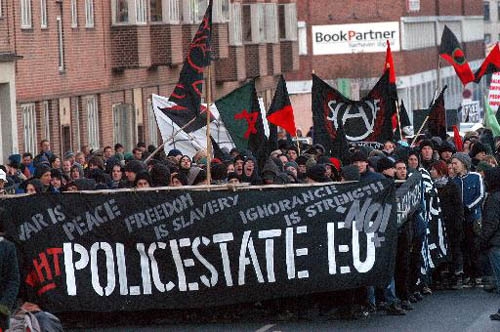
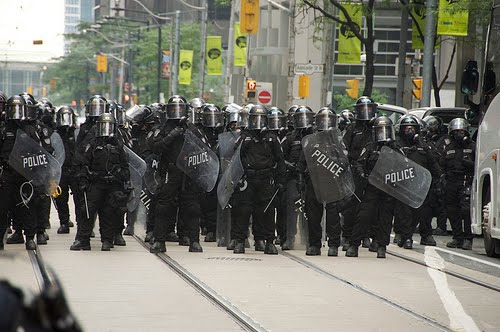

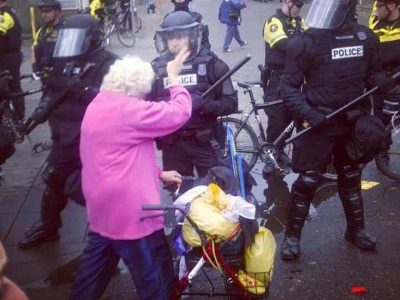
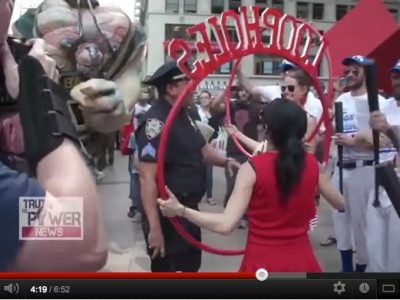
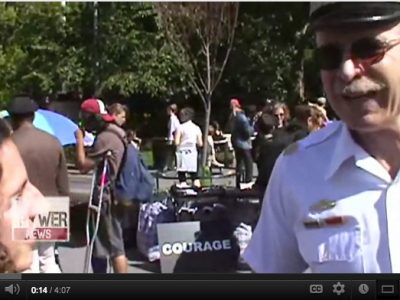
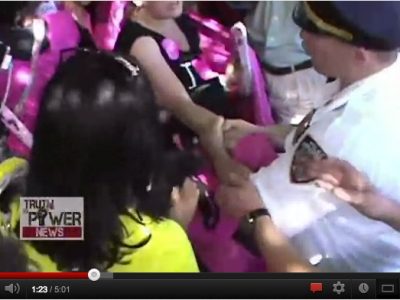
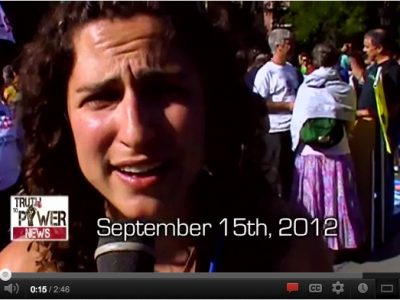
9 comments for “Black Bloc: A Brief History”